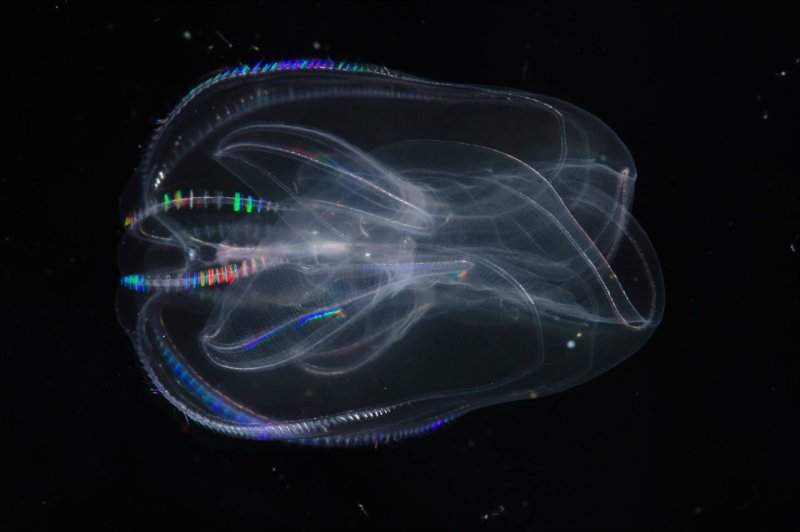Comb jellies (“ctenophores”) are surreal creatures, with fragile bodies often lined with striking bio luminescent lines.
Given that these animals are all but transparent, it’s hard to imagine them hiding anything at all. And to be fair, they are not hiding much: they are incredibly simple creatures, with only the barest minimum in terms of internal biological hardware.
But what they do have, they can regrow — including their rudimentary brain.
Any mention of neural regeneration will attract attention, because neuro-degenerative diseases like Parkinson’s and Alzheimer’s are some of the worst afflictions affecting our species. They don’t simply strike at our physical well-being but at the cores of our identity by robbing us of the ability to control our bodies and to remember loved ones.
If some animal can regrow its brain, you can bet we want to know how.
A new paper in Nature, explores the genetics underpinning of the comb jellies’ nervous system, shaking up the evolutionary tree and raising hope for regenerative medicine. The seven-year effort doesn’t reveal how comb jellies regenerate, but it does reveal a new path for neuroregenerative research.
Typically, genomic studies reveal the vast similarities of life — not so with comb jellies.
“They are remarkably distinct from other animal genomes in their content of neurogenic, immune and developmental genes,” write the authors.
[Many] neuron-specific genes and genes of ‘classical’ neurotransmitter pathways either are absent or, if present, are not expressed in neurons. Our metabolomic and physiological data are consistent with the hypothesis that ctenophore neural systems, and possibly muscle specification, evolved independently from those in other animals.
Here is an animal that has a brain … but is missing the genes we know are needed to build it. It would seem comb jellies evolved their own brains independently of the rest of life on earth. They use their own neurotransmitters, and their own unique genes, to build their brains.
Carl Zimmer, writing for National Geographic Magazine, got the scientists to elaborate:
“It’s a paradox,” said Leonid Moroz, a neurobiologist at the University of Florida in Gainesville and lead author of a paper in today’s Nature about the biology of the comb jelly nervous system. “These are animals with a complex nervous system, but they basically use a completely different chemical language” from every other animal. “You have to explain it one way or another.”
They way Moroz and company choose to explain it is by rearranging the tree of life so that cnetophores branched off essentially at the “base” of the tree, following their own path. Where once it was assumed there was only one route from the most primitive, nervous system-lacking organisms to the complexity of today’s brains.
There’s more than one way to build a brain, it seems. And that’s good news for regenerative medicine.
The authors of the paper write:
These findings are of relevance for regenerative and synthetic biology in designing novel signalling pathways and systems. In this case, ctenophores and their genomes present matchless examples of ‘experiments’ in nature and the possible preservation of ancient molecular toolkits lost in other animal lineages.
The Associated Press has a wonderful response from biologist Antonis Rokas of Vanderbilt University in reaction to the research:
“It’s almost like evolution has given us two different blueprints for building a structure that’s very important,” he added. “If your goal is to make a nervous system, it doesn’t matter what the parts are in some ways. You could potentially mix and match. The more parts you have, the more solutions.”
It’s all very exciting, but very much in the future. When it comes to primitive sea creatures holding the keys to human regeneration, we have a precedent for hype exceeding reality. A 2012 feature in the New York Times about the “immortality” of jellyfish — neither closely related to comb jellies nor, for that matter, immortal — drew fire from the Knight Science Journalism tracker for a dramatically overstated premise and shoddy reporting.
The most important finding in this genomic survey of the comb jelly is that it confirms their unique standing. They were already called “aliens of the sea” before; they’re more deserving of that moniker now more than ever.
Kenrick Vezina is Gene-ius Editor for the Genetic Literacy Project and a freelance science writer, educator, and naturalist based in the Greater Boston area.
Sources:
- “The ctenophore genome and the evolutionary origins of neural systems,” Nature
- “Strange Findings on Comb Jellies Uproot Animal Family Tree,” Carl Zimmer | National Geographic
- “‘Aliens of sea’ provide new insight into evolution,” Associated Press
Additional Resources:
- “Why Can’t We Prevent Alzheimer’s?” Jim Kozubekjan | The Atlantic
- “Jellyfish and Comb Jellies,” Smithsonian Ocean Portal
- “First we get proof of heaven; now the secret of immortality.” Paul Raeburn | Knight Science Journalism Tracker































